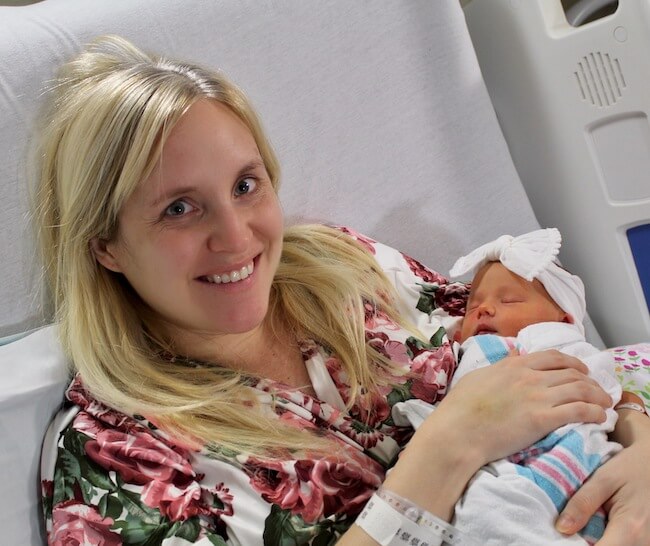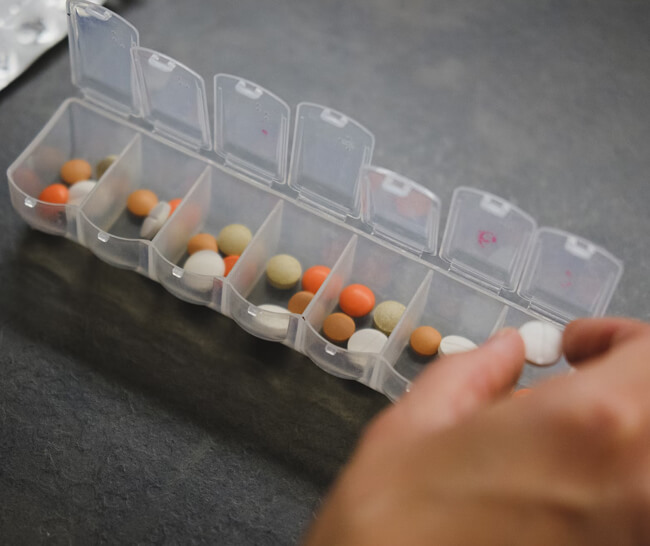If you’re anything like me and my group of mom friends, a top-ranking priority following delivery of our little ones was to reclaim our health—including shedding the baby weight from the last nine months.
If you’re in the same boat, what should you expect? Where should you start? Let’s talk about it!
Weight Lost During Childbirth
Let me begin by saying congratulations on your new bundle of joy! Take a minute to admire the amazing work your body endured to create and deliver this little life.
As you adjust to your newly transformed postpartum body, be reassured that your body is physiologically designed to shed most of the pregnancy weight.
Your body is resilient. In fact, you start the weight loss process during childbirth.
Throughout the birthing process, amniotic fluid flushing and delivery of baby and placenta leads to an average of about 13 pounds being lost during childbirth<sup>1</sup>.
The weight loss doesn’t stop there! Post-delivery, moms experience an increase in urine output in the hours and days following childbirth, adding to the weight loss total<sup>1, 2</sup>.
Frequent trips to the bathroom are in response to extra fluids given during the labor process and shifting of fluid storage from the hands, feet, and other parts of the body that store during pregnancy in response to cues from hormones. Say goodbye to swelling!
And yet, the body doesn’t stop there either—weight loss continues.
Note: Certain conditions, such as postpartum preeclampsia, may prolong fluid retention that may lead to altered patterns of weight decline and sometimes weight gain post-delivery<sup>3</sup>. If you cling to weight or weight increases and is accompanied with elevated blood pressure, headaches, vision changes, or other concerning symptoms, contact your women’s health provider (OB/GYN or midwife), as this may be a sign of a serious medical condition.
Postpartum Weight Loss Timeline
The postpartum weight loss timeline can vary based on weight prior to pregnancy, pre-delivery condition, labor and delivery experience, and postpartum adjustment.
The pounds typically continue to drop at a steady rate over the first six weeks. On average, half of the weight gained during pregnancy is lost during this immediate postpartum time.
Later postpartum (six weeks to one year), the rate of weight loss slows but continues<sup>4</sup>.
Restoration of loose skin takes longer when compared to weight loss. Skin on the abdomen and thighs become stretchy during pregnancy.
Skin changes in pregnancy are due to a combination of biological factors, including alterations in hormones, the body’s immune system, and increased blood flow throughout the body.
Postpartum loose skin will improve but will never fully return to its pre-pregnancy state. Skin on the stomach takes longer to tighten and is likely to look slightly different post-pregnancy. Skin on the thighs is more likely to return to a pre-pregnancy resemblance<sup>5</sup>.
Diet and exercise help with both dropping baby weight and reducing the appearance of loose skin after pregnancy<sup>5,6</sup>.
Create a Weight Loss Plan
Whether you are a weight loss beginner or have been down this road before, start by setting a realistic goal.
Targeting rapid weight loss can decrease the likelihood of permanently keeping the pounds off<sup>7</sup>. Instead, aim for slow and steady weight loss each week (0.5–2 pounds maximum) for long-term success.
While an average weight loss per week of a half-pound to up to two pounds can be motivating, give yourself grace if you don’t lose exactly that each week. Your body is recovering from a long period of stress, and labor is traumatic. Your hormones are re-adjusting, you’re sleep deprived, and are likely stressed from responding to your newborn’s around-the-clock needs. The weight loss will come.
Your Weight Loss Nutrition Plan
The most important part of your postpartum weight loss plan: meal planning. What you eat is arguably more important than exercise. As one expert commentary states, “You cannot outrun a bad diet<sup>8</sup>.”
Map out healthy meals and snacks, prep a standard grocery list, and identify go-to options when you’re too tired to spend time preparing food.
Plan to munch on lean proteins (fish and chicken); low-fat or full-fat dairy (plain yogurt, milk, cheese) if you can tolerate it—substitute plant-based options if you can’t; and whole, unprocessed, unrefined foods, such as<sup>9</sup>:
- Grains: Rolled oats, quinoa, farro, barley, sourdough or sprouted whole grain bread, black or wild rice
- Beans and legumes: Lentils, lima beans, split peas, chickpeas, black beans, peanuts, etc.
- Nuts and seeds: Raw almonds, cashews, walnuts, pistachios, sunflowers seeds, pumpkin seeds, chia seeds, hemp seeds, flaxseeds
- Fruits: Berries, pears, apples, grapefruit, tomatoes, avocado, cucumbers
- Vegetables: Broccoli, carrots, green beans, cauliflower, Brussels sprouts, asparagus, leeks, garlic, celery, cabbage, kale, and all the other green leafy favorites.
Postpartum moms need carbs, especially those breastfeeding. Include complex carbs and foods that curb blood sugar spikes in your meal plan<sup>10</sup>. By stabilizing your blood sugar, the body flips to fat-burning faster and will promote consistency in weight loss results. We’ll revisit this key topic shortly.
Selecting nutrient-dense, high-quality carbs is important. Steer away from simple carbs and processed, refined carbs.
- Simple carbs: honey, sugar, corn syrup, and candy
- Processed, refined carbs: white breads, white crackers, white pasta, cereal bars, cookies, muffins, pastries, etc.
Consume caffeinated beverages in moderation. Caffeine is a common crutch that many parents rely on due to sleep interruptions and general fatigue with the unique schedule a baby brings into the household.
While caffeine passes through to breastmilk, low to moderate amounts around two to three cups of coffee per day (or equivalent of 300 milligram or less per day), do not typically have negative effects on babies<sup>9</sup>.
Relative to weight loss, there are studies<sup>11, 12, 13</sup> that suggest there might be benefits to caffeine consumption, specifically coffee. The amount of evidence does not warrant a recommendation for weight loss or contemplate risk versus benefits related to caffeine intake.
As a two-time mom myself, I can relate to those who missed their occasional glass of wine (or two) with dinner throughout the week during pregnancy. Is it worth resuming?
The increased caloric intake associated with alcohol intake can have a negative impact on weight loss. Alcohol can also influence impulsive behaviors, such as overeating, that can impede reduction of weight.
Alcohol impacts breast milk as well. Nursing after a drink or two can decrease an infant’s milk intake by 20–23% and may cause irritability and poor sleep quality. An occasional drink is unlikely to have a negative impact on a nursing infant<sup>14</sup>. Consider sticking to “no alcohol” when creating your weight loss plan. Or, save a drink for a rare special occasion.
Ease Into Exercise
Unlike nutritional planning, a start date for exercising may prove difficult to schedule.
Resuming or introducing moderate to high-intensity exercise and weightlifting postpartum should be customized to the new mom with consideration to delivery complications, current health status, and under advisement of a healthcare professional<sup>15</sup>.
Postpartum Exercise Plan
Consider adapting the following postpartum exercise plan with your healthcare provider to meet your needs and pace:
Exercise: Weeks 1-3 After Birth:
<ul><li>Return to housework</li><li>Start walking in 10-minute increments several times per day, and</li><li>Work on pelvic floor exercises as tolerated<sup>16</sup>. Here are some core and pelvic floor exercises you can do at home.</li></ul>
Exercise: Weeks 3-6 After Birth:
<ul><li>Continue to build on daily activity with light core and total body exercise, and</li><li>Consider using an abdominal binder to support your abdominal muscles and relieve pain and soreness with additional movement<sup>17</sup>.</li></ul>
Exercise: Week 6-8 After Birth:
When medically cleared, slowly ramp up to the Physical Activity Guidelines for Americans<sup>18</sup>:
- Gradually increase activity for an accumulative 2.5 to 5 hours of moderate-intensity aerobic physical activity each week, and
- Cautiously re-introduce muscle-strengthening exercises at low settings that engage all major muscle groups 2 times per week or more.
Increase machine settings and weight as tolerated until returning to pre-pregnancy benchmarks, which may take as long as three months. Include abdominal exercises to rebuild muscle and prevent abdominal muscle separation<sup>19</sup>.
Exercising not only helps weight loss but also helps fight postpartum depression. Light-to-moderate exercise has also been shown to decrease mild-to-moderate depressive symptoms and the frequency of postpartum depression. Exercise also increases the likelihood that mild-to-moderate depression will completely resolve<sup>20</sup>. That said, if you experience prolonged sadness, insomnia, loss of appetite, intense irritability or anxiety, and trouble bonding with your baby, talk to your doctor.
{{mid-cta}}
Vaginal Childbirth and Weight Loss
Vaginal deliveries lead to faster healing. Within days of giving birth, most new moms are ready and able to increase activity throughout the day as tolerated, including routine housework and light exercise movements<sup>21</sup>.
Over the next several weeks, exercise intensity may increase until returning to pre-pregnancy performance<sup>22</sup>.
With a shorter recovery time following a vaginal delivery, diet and exercise can usually resume more quickly, which can lead to earlier weight loss compared to deliveries with surgical intervention requiring a longer recovery.
C-sections and Weight Loss
Since c-sections have a longer recovery, it may take a little longer to lose weight. And that’s okay!
The best way to ensure a timely recovery is to support the healing process and prevent complications. One way you can do this is by getting out of bed early-on after surgery and walking with approval from your healthcare team<sup>23</sup>.
Earlier movement reduces the likelihood of risky conditions that can occur after surgery. Walking can also help return optimal physical function without delays<sup>24</sup>.
When free of pain following a c-section, the new mom can start with light exercise movements as tolerated. The American College of Obstetricians and Gynecologists (ACOG) recommends staying away from lifting objects heavier than your newborn temporarily to prevent the incision site from reopening<sup>25</sup>.
The addition of strenuous exercise, including weight lifting, will be dependent on the healing process at the incision site and medical clearance<sup>25</sup>.
Breastfeeding and Weight Loss
Lactation uses more energy in the body, expending an estimated 450 to 500 additional calories per day<sup>26</sup>.
One weight loss strategy includes consuming the same number of calories you did before pregnancy. This method uses the calorie deficit from breastfeeding to target weight loss and is unlikely to deplete your milk supply.
If your milk supply dwindles, poor nutrition and hydration are the most likely culprits<sup>26</sup>. To prevent milk supply issues while trying to lose weight:
<ul><li>Avoid over restriction of calories and excessive food limitations, and</li><li>Drink 3.3 liters (112 ounces) of water per day for adequate hydration<sup>27, 28</sup>.</li></ul>
It’s important to maintain a well-balanced, nutrient-dense diet that includes several food groups and variety to ensure mom and baby receive much-needed vitamins and minerals<sup>27</sup>.
Your health provider may advise continuation of a prenatal or multivitamin to meet additional nutritional demands while nursing.
Worried that exercise for weight loss will deplete your milk supply? Worry no more!
Weight loss by diet alone and by a combination of diet and exercise had no significant impact on breastfeeding according to one study. There was no change in milk volume, composition, energy spent, or infant weight<sup>29</sup>.
Another study demonstrated that postpartum weight loss at a rate of 2 pounds per week through diet and exercise is safe in lactating women. In fact, the study notes that the combination of diet and exercise for weight loss is preferable to diet only to maintain muscle mass<sup>30</sup>.
In general, breastfeeding moms should stick to moderate-intensity exercise. High-intensity exercise may affect milk acceptance and supply, though the evidence is unclear<sup>29, 31</sup>.
Pro-tip: Nurse your infant prior to exercise. Pre-exercise nursing helps prevent temporary feeding issues related to infant acceptance and increased acidity in breast milk following physical activity. It also supports a more comfortable workout for mom by preventing breast engorgement<sup>25</sup>.
Dealing with Weight Loss Plateaus
Weight loss plateaus can be frustrating to say the least. Prevent plateaus by maintaining accountability to your meal and exercise plan.
- Join forces with a friend who is also trying to lose weight
- Join a mommy & me class
- Enroll in a fitness class
- Find another way to ensure you’ll show up for yourself!
When weight loss stalls for two weeks or longer, it’s time to do some investigation.
Ask yourself:
- How’s my nutritional intake?
- Am I engaging in movement throughout the day?
- Have I been gradually increasing exercise challenges?
- Did I stick to the plan?
If you’re sticking to a plan and the scale isn’t budging, try monitoring your nutritional intake more closely. Consider:
<ul><li>Reviewing labels for ingredients that may increase hunger or cravings, like artificial sweeteners <sup>32</sup></li><li>Measuring your food to see how your portion sizes add up</li><li>Cutting back on or (temporarily) eliminating extra calories from beverages or treats</li><li>Monitoring your blood sugar levels</li></ul>
Calorie counting can help with awareness but it misses one big factor that commonly fluctuates in women during pregnancy and after delivery: hormones.
Tracking your blood sugar can help you understand how foods impact hormone levels<sup>33</sup>.
By monitoring your blood sugar, you can identify those certain foods that cause a jump in blood sugar. In response, the body produces the hormone insulin to bring your blood sugar down.
Over time, frequent cycling of spiking blood sugars causes additional insulin to be released to handle the extra glucose. Sometimes cells stop responding to insulin. If the excess glucose is not burned due to insulin resistance, it’ll go into storage in the muscles and liver; when those stores are full, the unused glucose gets stored in adipose tissue as fat. Not burning through your energy stores stonewalls weight loss.
Continuous glucose monitoring (CGM) has been shown to encourage eating and exercise behaviors that promote weight loss, according to one study on CGM use in diabetics<sup>34</sup>. Glucose monitoring combined with a weight loss program like Signos may be especially helpful for postpartum women who experienced unstable blood sugar during pregnancy<sup>35</sup>.
By learning how your body responds to the foods you eat and when you eat them, you can begin to avoid foods that cause a roller coaster effect on your glucose.
In turn, your body will stop overproducing insulin. The Signos app can show you windows of opportunity when you can exercise to use extra glucose and burn fat more consistently. And, ultimately, the number on the scale will go down—bye bye, baby weight!
Learn more about using CGM for weight loss here.
Starting Your Postpartum Weight Loss Journey
Before you launch into a full-blown mission to lose the baby weight and tone your tummy, give yourself some time to recover from the delivery and newborn stage. Stress works against weight loss<sup>36</sup>.
After a few deep breaths, it’s time to execute your plan and reclaim wellness to feel good, look your best, and prevent issues related to postpartum weight retention<sup>37</sup>.
Lastly, stay the course! And remind yourself that postpartum weight loss is a journey, not a sprint.
References
1. https://www.ncbi.nlm.nih.gov/books/NBK555904/
2. https://www.jognn.org/article/S0884-2175(15)34387-2/fulltext
3. https://www.ajog.org/article/S0002-9378(20)31201-1/fulltext
4. https://pubmed.ncbi.nlm.nih.gov/11439300/
5. https://pubmed.ncbi.nlm.nih.gov/29479745/
6. https://pubmed.ncbi.nlm.nih.gov/26313354/
7. https://pubmed.ncbi.nlm.nih.gov/28845608/
8. https://bjsm.bmj.com/content/49/15/967.full
9. https://www.dietaryguidelines.gov/resources/2020-2025-dietary-guidelines-online-materials
10. https://www.hsph.harvard.edu/nutritionsource/carbohydrates/carbohydrates-and-blood-sugar/
11. https://pubmed.ncbi.nlm.nih.gov/30335479/
12. https://www.nature.com/articles/ejcn2015183
13. https://pubmed.ncbi.nlm.nih.gov/17023692/
14. https://www.ncbi.nlm.nih.gov/books/NBK501469/
15. https://pubmed.ncbi.nlm.nih.gov/32217980/
16. https://medlineplus.gov/ency/patientinstructions/000141.htm
17. https://www.ncbi.nlm.nih.gov/pmc/articles/PMC6812913/
18. https://health.gov/our-work/nutrition-physical-activity
19. https://pubmed.ncbi.nlm.nih.gov/16449116/
20. https://pubmed.ncbi.nlm.nih.gov/28486363/
22. https://bjsm.bmj.com/content/52/17/1080
23. https://www.ajog.org/article/S0002-9378(17)31850-1/fulltext
24. https://pubmed.ncbi.nlm.nih.gov/23340879/
25. https://www.acog.org/womens-health/faqs/exercise-after-pregnancy
26. https://www.nichd.nih.gov/health/topics/breastfeeding
27. https://nal.usda.gov/legacy/fnic/nutrition-during-pregnancy
28. https://bmcpregnancychildbirth.biomedcentral.com/articles/10.1186/s12884-019-2301-z
29. https://pubmed.ncbi.nlm.nih.gov/9927017/
30. https://pubmed.ncbi.nlm.nih.gov/10232637/
31. https://pubmed.ncbi.nlm.nih.gov/1521957/
32. https://www.ncbi.nlm.nih.gov/pmc/articles/PMC2892765/
34. https://www.ncbi.nlm.nih.gov/pmc/articles/PMC7164990/
35. https://drc.bmj.com/content/8/2/e001728
36. https://www.ncbi.nlm.nih.gov/pmc/articles/PMC6296480/
37. https://www.ncbi.nlm.nih.gov/pmc/articles/PMC4286308/
- Item 1
- Item 2
- item 3
































